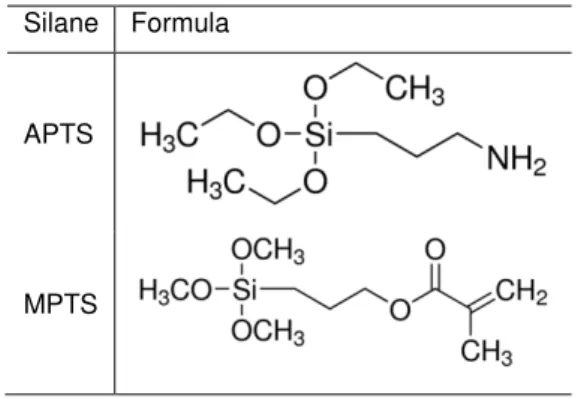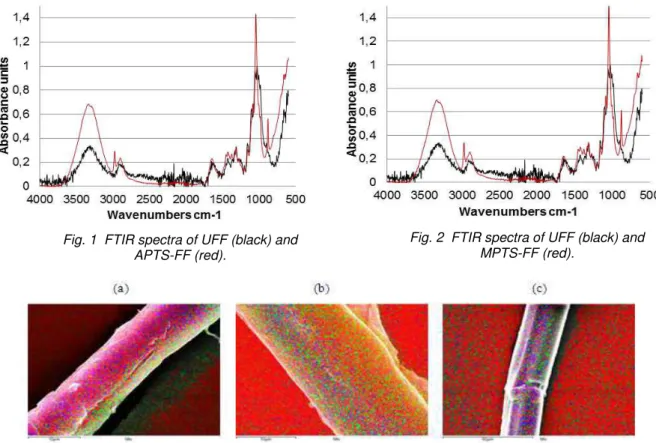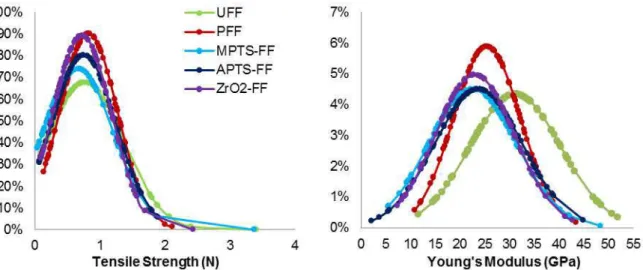First International Conference on Bio-based Building Materials
June 22nd - 24th 2015
Clermont-Ferrand, France
EFFECT OF ZIRCONATES AND SILANES TREATMENTS ON THE PHYSICAL
AND MECHANICAL PROPERTIES OF FLAX FIBERS FOR APPLICATIONS IN
CEMENTITIOUS COMPOSITES
L. Boulos, M. Foruzanmehr, M. Robert*
Carrefour of Innovative Technology and Ecodesign (CITE), Faculty of Engineering University of Sherbrooke, 2500 boul. de l’Université, Sherbrooke, Canada
*Corresponding author; e-mail: Mathieu.Robert2@USherbrooke.ca
Abstract
The advantage of natural fiber reinforced cement composites (NFRC), especially flax fibers based composites, lies in the improvement of mechanical and thermal properties of the matrix, and in the reasonable cost. However, the wide use of these materials is hampered by their low stability. The natural fiber in the porous alkaline matrix is slowly damaged and the reinforcing effect of the fiber decreases. Fiber treatment can be used to improve aging of the NFRC. This approach can have the advantage of improving the fiber–matrix interface and the hydrophobicity of the fiber. Chemical grafting of functional groups at the surface of fibers is a promising process for improving durability and adhesion of flax fibers used as reinforcement material in a cementitious matrix. This research gives an insight into the effect of chemical modification of flax fibers by two different sizings: (1) alkyltrialkoxysilane (RSi(OR′)3) and (2) zirconium butoxide
(Zr(OCH2CH2CH2CH3)4). Chemical treatments at the fiber surface were characterized by
Scanning electron microscopy (SEM) and Fourier transform infrared spectroscopy (FTIR). Moisture absorption measurements at room temperature and 80% of relative humidity were carried out in order to study the hydrophobicity of the modified fibers. Tensile tests were performed on fibers to determine the sizing effects on mechanical properties of the treated flax fibers. Fibers degradation was evaluated by measuring the variations in tensile strength after exposing them to alkaline solutions. The results show significant effects of the surface treatments on the hydrophobicity of the flax fibers and the prevention of their degradation in a cementitious simulated environment. In particular, surface treatment with zirconates significantly improves the water resistance of the fibers, while silane efficiently improves the resistance of the fibers against degradation when immersed in an alkaline solution.
Keywords:
Flax fibers, Coating, Zirconates, Silanes, Cementitious composites
1 INTRODUCTION
There is a growing interest in using natural fibers as reinforcements in building composites. In fact, such composites can reduce environmental impacts as they are recyclable and compostable materials. Moreover, in comparison with inorganic fibers, natural fibers present many advantages such as their low cost, low density and their non-abrasive property [Savastano Jr and Warden, 2005]. However, their high capacity in absorbing moisture induces a detrimental effect on composites performance. The fiber/matrix bonding quality decreases in time in the presence of moisture, which leads to a decreasing of the mechanical properties of the material. Moreover, another drawback of the use of natural fibers in cement applications is their degradation due to the high alkaline environment of the cementitious matrix
[Agopyan, 2005]. Natural fibers need therefore to be treated before using them in cementitious composites in order to avoid fibers degradation and enhance the fibers/matrix interfacial bonding. Different approaches have been investigated to modify the surface properties of the natural fibers: physical treatments (mostly solvent extractions), physico-chemical treatments (use of laser, γ-ray, UV irradiations) and chemical modifications (silane treatments, acetylation) [Belgacem and Gandini 2005].
In this paper, the work focuses on the chemical treatments of flax fibers as flax production is a large industry in Canada. It is in fact the largest flaxseed producer in the world. Despite its potential as a value-added product, residual flax straw is currently being burned by farmers. Transforming waste into innovative bio-products by using flax fibers as a reinforcement material in building composites is thus
a great opportunity for Canada [Kalia 2011]. In addition, their mechanical properties are similar to the glass fibers used as reinforcement [Yan, Chouw et al. 2014]. The chosen chemical treatments for the surface modification of the flax fibers were silane and zirconate treatments. Alkyltrialkoxysilanes R’Si(OR)3
are widely used in industries as water repellents and coupling agents for improving the interface between inorganic materials or natural fibers and polymeric matrices [Bilba and Arsene 2008]. While, to the best of our knowledge, no research has been conducted on ZrO2 thin film coated on flax fibers. The effects of
these treatments on the mechanical properties and the hydrophobicity of the flax fibers and their stability against alkaline environment were investigated.
2 EXPERIMENTATION 2.1 Materials
The oilseed flax fibers were supplied from Saskatchewan, Canada. All the chemical components used for silane and ZrO2 treatments
were purchased from Sigma-Aldrich.
2.2 Fibers pre-treatments
De-waxing treatment
In order to remove the wax, fibers are treated by boiling acetone under reflux for 45 minutes.
Alkali treatment
After de-waxing, the fibers were immersed in 5% sodium hydroxide solution for 40 minutes and immediately washed with distilled water. To fully neutralize the effect of NaOH a verydilute acetic acid solution was applied which followed by rinsing with distilled water. The fibers were dried in an oven at 50°C overnight.
2.3 Fibers treatments
Zirconium treatment
The pre-treated flax fibers were then coated with a ZrO2 Sol. To prepare the Sol, zirconium butoxide was
used as a precursor and nitric acid as a peptizer. The water used in preparing ZrO2 was doubly distilled
and deionized. The ZrO2 sol was synthesized as
follows: a mixture of 30 mL (0.12 mol) of zirconium butoxide and 5 mL of ethanol was added to 180 mL of water in a 500-mL jacketed Erlenmeyer flask to provide a zirconium butoxide-ethanol-water molar ratio of 1:0.75:83. Then, 2 mL of nitric acid was added to the zirconium butoxide solution maintained at 20°C by circulating a coolant with a circulating chiller. The resulting sol was refluxed at 80°C for 12 hours under vigorous stirring (using a magnetic stirrer), which resulted in a milky solution. Thereafter, it aged for 48 hours at room temperature in the air. The coating was conducted by immersing the fibers into the Sol for 30 seconds. The coated fibers were then heated to 70°C in order to remove the solvents and then put in an autoclave at 120°C for a one-hour cycle; this allows the formation of zirconium dioxide.
Silane treatment
The following procedure used was described by Tonoli et al [Tonoli, 2009].Two types of silanes were used (3-aminopropyl)triethoxysilane (APTS) and [3-(Methacryloyloxy)propyl]trimethoxysilane (MPTS). Their chemical structures are given in Tab. 1. The
Then, the pre-treated flax fibers were added to the silane solution and the stirring was maintained for an additional 2h. Finally, the flax fibers were centrifuged at 1400 rpm for 2 min.
Tab. 1 The two types of silane coupling agents used for this work.
Silane Formula
APTS
MPTS
The untreated flax fibers are noted UFF, the pre-treated flax fibers PFF, the zirconia coated flax fibers ZrO2-FF, and the APTS and MPTS coated flax fibers
respectively APTS-FF and MPTS-FF.
2.4 Characterization of fibers treatments
Fourier-Transform Infrared Spectroscopy (FTIR)
FTIR analyses were conducted on different types of fibers. These analyses were performed to determine if the silane treatments were able to coat the pre-treated flax fibers. FTIR spectra were recorded using a Nicolet Magna 550 spectrometer equipped with an attenuated total reflectance (ATR) device. Fifty scans were routinely acquired with an optical retardation of 0.25 cm to yield a resolution of 4. Fig. 1 and Fig. 2 show the presence of bands at 880, 1040 and 1080 cm-1. These bands are assigned to the silanes [Pouchert, 1985]. This provides evidence about the effective coating of the two silanes APTS and MPTS on the flax fibers.
Scanning Electron Microscopy (SEM)
In order to check the effective coating of the fibers with silanes and zirconium, coated flax fibers were examined by SEM (Hitachi S-3000N) with Secondary Electron (SE), and Energy Dispersive Spectroscopy (EDS) detectors. Fig. 3 shows SEM images of the three coated flax fibers (ZrO2-FF, APTS-FF and MPTS-FF). Green points can be seen in each picture, this indicates the presence of zirconium in (a) and silicium in (b) and (c). The tested coatings were thus effective.
2.5 Characterization of fibers
Tensile test
The uniaxial tensile test equipment was used to perform tensile tests on single flax fibers. The Young modulus (E) and the maximum tensile strength (FH)
were determined. All the tensile tests were performed using a 50kN Allround table top Zwick/Roell Z050 testing machine equipped with a 5N load cell. Tensile tests were conducted in displacement control with a crosshead speed of 200 mm/min at room temperature. 80 samples of single fiber were tested for each condition. Considering the high values obtained for the standard deviation, an average of
Moisture absorption
Moisture absorption measurements were performed using the H300 Temperature Humidity Chamber. The mass of the different types of flax fibers was taken after conditioning at 25°C and 80% relative humidity for 24h. Flax fibers were then removed from the chamber and weighed immediately.
Fibers degradation
In order to simulate the fibers degradation in cementitious materials, an alkaline solution (pH=13) rich in calcium was prepared by adding 1.7g of calcium hydroxide and 5.2 g of sodium hydroxide in 1 L of distilled water. The flax fibers were immersed in this lime-saturated solution for 24 hours.
3 RESULTS 3.1 Tensile test
Tensile tests performed on flax fibers gave the results presented in Fig. 4 and Fig. 5. The normal distribution of the tested samples shows no significant difference of the tensile strength between untreated and treated fibers. This is because the tensile strength mostly depends on the fiber itself and the treatments especially silanisation cannot have a strong effect on the mechanical properties. However, the Young’s modulus decreased after the pre-treatments of the flax fibers. This is attributed to the chemical treatments which lead to excess delignification of the fibers and significant degradation of the cellulose chains. Indeed, it was proved that chemical treatments were responsible for
the decrease of the fibers strength as they lead to breakage of the bond structure and disintegration of the non-cellulosic materials[Kalia, Kaith et al. 2009]. As the results obtained with the APTS-FF were similar to the ones obtained with the MPTS-FF, next tests (water absorption and fibers degradation) were only performed on MPTS-FF.
3.2 Moisture absorption
Table 2 shows the amount of moisture absorption for each condition tested. It is clear that pre-treatment of the flax fibers increases the hydrophilicity of the fibers because extraction of the wax with acetone and also alkaline treatment pave the way for enhancing the exposure of OH groups present on cellulose to water molecules. On the contrary, silanisation with MPTS decreases the hydrophilicity as the OH groups were replaced by the silane ones. Moreover, ZrO2-coated flax fibers (ZrO2-FF) exhibit
the lowest moisture absorption. This could be explained by the formation of a thin film of ZrO2 on
the flax fibers which protects the fibers against water permeation.
Tab. 2 Moisture absorption values of the different flax fibers tested
UFF PFF ZrO2-FF MPTS-FF Moisture
absorption (%) 4.9 7.0 3.1 4.4
Fig. 1 FTIR spectra of UFF (black) and APTS-FF (red).
Fig. 2 FTIR spectra of UFF (black) and MPTS-FF (red).
Fig. 3 SEM images of a (a) ZrO2-FF, (b) APTS-FF and (c) MPTS-FF. Red = C / Blue = O / Green = (a) Zr, (b) Si, (c) Si.
3.3 Fibers degradation
The fibers degradation in a cementitious simulated environment was studied for untreated flax fibers (UFF), zirconia coated flax fibers (ZrO2-FF) and
MPTS coated flax fibers (MPTS-FF). Figure 5 shows the flax fibers mechanical properties before conditioning (dotted lines) and after conditioning (solid lines) in an alkaline solution (pH=13) rich in calcium. A decrease of the mechanical properties is
mechanical properties is higher for the untreated flax fibers comparing to the coated ones.
Indeed, the tensile strength decreases by 34% for untreated flax fibers whereas it decreases by 23% for zirconia coated flax fibers and only by 9% for the MPTS coated flax fibers. The Young’s modulus decreases by 43% for untreated flax fibers while it decreases by 28 % and 6% for zirconia coated flax fibers and MPTS coated ones, respectively. This
Fig. 4 The effects of the pre-treatment, silane treatments (MPTS and APTS) and zirconium treatment on (a) the tensile strength and (b) Young’s modulus of flax fibers.
Fig. 5 The effects of the exposure of the fibers to a solution saturated in calcium and having a pH of 13 on (a) the tensile strength and (b) the Young’s modulus.
Tab. 3 Average values of the tensile strength and the Young’s modulus of the flax fibers before and after conditioning in a cementitious simulated environment and their given percentage of loss.
UFF PFF ZrO2-FF APTS-FF MPTS-FF
Tensile strength (N) Before conditioning 0.77 0.83 0.73 0.75 0.67 After conditioning 0.51 - 0.56 - 0.61 % Loss 34 - 23 - 9 Young’s Modulus (GPa) Before conditioning 31.18 25.43 23.00 23.71 22.51 After conditioning 17.74 - 16.55 - 21.10 % Loss 43 - 28 - 6
obtained from the two coatings clearly shows a better efficiency of the MPTS in protecting the fibers against the alkaline degradation.
4 CONCLUSIONS
Two different coatings of flax materials were investigated in this study, a ZrO2 coating and a silane
coating. This work was performed on single flax fibers which were previously pre-treated using a de-waxing process and an alkaline treatment. Then, coatings were performed on the pre-treated flax materials. FTIR spectra and SEM images indicated that the coatings were both effective. Water absorption measurements were carried out in order to study the hydrophobicity of the modified fibers. Tensile tests were performed to determine the coating effect on the mechanical properties of the fibers. Fibers degradation was evaluated by measuring the variations in tensile strength and Young’s modulus after exposing them to an alkaline solution. The results obtained show that the ZrO2
coatingcould efficiently improve the hydrophobicity of the flax fibers and also protect them against alkaline degradation. Silane coating showed a great efficiency in preventing the fibers degradation when exposed to a cementitious simulated environment but it could just slightly improve the hydrophibicity of the fibers. These results were obtained from preliminary tests. The fibers degradation tests will be repeated for 28 days instead of the 24 hour tests that were done in order to better simulate the setting of a cementitious composite.
5 REFERENCES
[Agopyan, 2005] Agopyan, V., H. Savastano Jr, V. M. John and M. A. Cincotto (2005). "Developments on vegetable fibre–cement based materials in São
Paulo, Brazil: an overview." Cement and Concrete Composites 27(5): 527-536.
[Belgacem, 2005] Belgacem, M. N. and A. Gandini (2005). "The surface modification of cellulose fibres for use as reinforcing
elements in composite materials." Composite Interfaces 12(1-2): 41-75.
[Bilba, 2008] Bilba, K. and M. A. Arsene (2008). "Silane treatment of bagasse fiber for reinforcement of cementitious composites." Composites Part A: Applied Science and Manufacturing 39(9): 1488-1495.
[Kalia, 2011] Kalia, S. (2011). Cellulose fibers: bio- and nano-polymer composites green chemistry and technology. Berlin, Heidelberg, Springer-Verlag Berlin Heidelberg.
[Kalia, 2009] Kalia, S., B. S. Kaith and I. Kaur (2009). "Pretreatments of natural fibers and their application as reinforcing material in polymer composites—A review." Polymer Engineering & Science 49(7): 1253-1272.
Pouchert, C. J. (1985). The Aldrich Library of FT-IR Spectra.
[Savastano, 2005] Savastano Jr, H. and P. G. Warden (2005). "Special theme issue: Natural fibre reinforced cement composites." Cement and Concrete Composites 27(5): 517.
[Tonoli, 2009] Tonoli, G. H. D., U. P. Rodrigues Filho, H. Savastano Jr, J. Bras, M. N. Belgacem and F. A. Rocco Lahr (2009). "Cellulose modified fibres in cement based composites." Composites Part A: Applied Science and Manufacturing 40(12): 2046-2053.
[Yan, 2014] Yan, L., N. Chouw and K. Jayaraman (2014). "Flax fibre and its composites – A review." Composites Part B: Engineering 56(0): 296-317.


